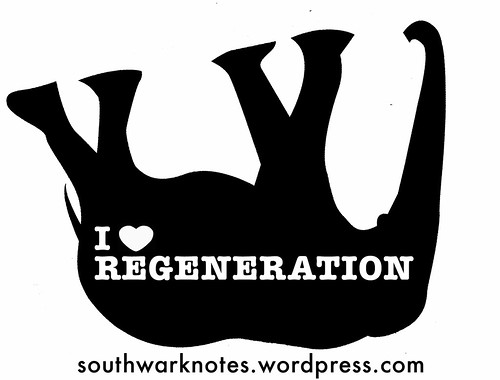In Southwark over the last two years there has been a lot of disquiet about where some of the promised 11,000 new council homes will be built. We’ve already posted up a long and good read on the discontents of some of Southwark Council’s plans to build as infill development on existing estates where amenities such as gardens, ball courts, playgrounds, garages and T.R.A halls have been earmarked as sites for the new homes. Several estates have formed campaigns and the umbrella group Yes To Fair Redevelopment has been crucial in sharing knowledge, support and solidarity to many of the groups concerned about loss of amenities and questions of safety all the while recognising the importance of supporting new council homes where not opposed.

But a further twist in the tale is Southwark’s now increasing support for using Roof Top Homes on top of existing estate blocks as a way to increase the number of new council homes because precious other land is unavailable or building on. For a few years now the idea of Roof Top Homes has been a big hit for developers and there are now numerous new Government orders and directives that make roof top extensions easier and possible. Those developers have gathered together around the idea of ‘Airspace’. Literally developers see the empty space above homes now as potential development sites. Knowing the things we all now know, this probably isn’t going to go well and tenants and residents on estates earmarked for new Roof Top Homes are understandably nervous and don’t trust that these new homes will be safe. However, the Councils support for the roof top homes seems to be full steam ahead. Leo Pollak, Southwark Labour poster boy for new council homes and former Cabinet Member for Housing forced to resign for online bullying of local campaigners, has been cheerleading roof top homes for quite a while. You can see him here talking up the Council’s plans in video part-sponsored by ApexAirspace who happen to be active and building in Southwark already!

But across estates there is lots of concern about any new roof top homes. For example, on Southampton Way Estate, the Tenants’ and Residents’ Association wrote an open letter to councillor Stephanie Cryan urging her to reconsider the council’s proposals to build two extra storeys across the Peckham estate. The group described the current plans as potentially ‘fatally flawed’. A letter, organised by chair Nick Flower, states: ‘Residents on Southampton Way Estate are justifiably very worried and concerned the council is proposing to go ahead and build on blocks which its own feasibility study recommended against. Doing so without presenting any indication that extensive structural surveys have been done to justify a decision which goes against its own expert opinion… And in doing so have set themselves on course to construct a fatally flawed rooftop development which risks the lives of a great number of residents‘.

We’ve been speaking to many tenants and residents through March 2022 about plans for infill and roof top homes, we heard again and again that people simply don’t trust the Council to listen to their concerns or to believe that the Council will act in their best interests as tenants or homeowners. As a bottom line for discussions about how to increase the number of new council homes in Southwark, this is a very poor starting point. Folks simply look at how run down their estates are, how repairs are harder and harder to get done, how the Council says one thing but means another, how people don’t trust ‘consultation’ etc.
In the last few months before the May 2022 local council elections, Southwark has put on hold, cancelled meetings and gone a bit quiet at many of the sites they want to infill and build on the roof. Although this may seem like they are finally listening to local people, local campaigners fear that this is just the Council going quiet and avoiding conflict in the run up to the elections. Whatever happens on May 5th, folks will keep on keeping on and working to insist on fair redevelopment or none at all on their estates.
NUNHEAD ESTATE, INFILL and ROOF TOP HOMES
Nunhead Estate is a small collection of mostly low rise London County Council-built blocks right by Peckham Rye. For a few months now, folks on the estate have been organising themselves to survey tenants concerns and fears. Recently we went down there to see the blocks and the estate amenities where infill and rooftop development are planned and to meet some of them and to hear about their campaign. It’s a perfect case study of disgruntled tenants and residents who are both against the loss of the playground that nestles safely inside the estate as well as being very nervous about disruption and safety concerns of such a very new development industry such as Airspace. They’ve been writing a lot online and we asked them if we could take their social media output and expand it for a short article to publicise why people are sadly forced to campaign against new council homes on their estates.



Nunhead Estate in Their Own Words (April 2022)
SAVE NUNHEAD ESTATE writes: This week we wrote to the council presenting letters of objection signed by over two thirds of households on our estate. The council claim we’re “increasingly positive” about the plan. That’s news to us! Here are just some of our concerns:
Safety:
The fact is there is no significant track record of rooftop build being completed successfully on mid-century council stock. Southwark are planning to roll out rooftop build to around 28 estates without any example of a successful rooftop build in the borough on a council block of this age. The ARUP* report undertaken by Southwark to look into Roof Top Homes has said rooftop builds on pre-70s blocks can cause disproportionate collapse. Disproportionate collapse could result in death. Southwark says it’s safe. Where’s the evidence? Certainly their own attempts so far have not given solace to those facing potential new homes on top of existing blocks.
For example, residents were promised by Southwark that the build in Chilton Grove, Rotherhithe would be complete by winter 2020. 3 years later, the roof isn’t even on because of concerns the existing apartment blocks will buckle under the weight of the extra floors. Additionally, we are aware of many rooftop builds around the UK, where problems – with falling cladding, leaks, and even cracks resulting from damage to the structural integrity of the building – have arisen after a rooftop build was complete and signed off by planning permission. As developers and freeholders are reluctant to take responsibility, it is then residents who are left to deal with the inconvenience, expense and danger of living in a compromised building. With the building safety crisis, the government is already trying to clean up the mess left behind by rushed development which has left thousands of people living in dangerous buildings facing immense stress and huge bills for remediation. Councils have also collectively been left facing a bill of billions in the wake of this disaster. In our view, rooftop build has all the hallmarks of the cladding scandal, mark two.
Disruption and Damage
The council promises minimal disruption. By contrast, the Antony & Roderick blocks redevelopment, an ongoing collaboration between developers ApexAirspace and Lambeth & Southwark Housing Association, shows the reality of rooftop builds. Despite promises “modular construction” would mean noise is kept to a minimum, residents have described life on a building site as a “living hell” with one telling the local paper, “it feels like 1000 men with 10,000 hammer drills are in my house.” Builders have drilled through walls and flooded flats and as the build has fallen further and further behind promises about construction times have been broken with residents enduring noise in their homes six days a week, from 7.30am. The local paper quotes a young mother who tripped and fell holding her baby due to a leak caused by the rooftop build, and the wife of a man who’s mental and physical health problems have worsened due to being stuck on a construction site day in day out.
Southwark News writes: ‘A Bermondsey woman has spoken of her “horror” as water came pouring through the ceiling of her top floor flat while builders were working on an “airspace” extension on the roof. Zeynep Yenil, who lives in Roderick House on Raymouth Road, said she and her four young children – including a baby – have been forced to “live through a nightmare” in recent weeks because of work done by developers Apex Airspace to her block, alongside landlords Lambeth and Southwark Housing Association (LSHA)…Ms Yenil told a hair-raising story of how when the flooding first happened a few weeks ago, she was carrying her five-month old baby through the flat. “I was taking my son to the bedroom and suddenly I slipped on my laminated flooring, and I smacked my five-month old son’s head on the floor. “I didn’t know that it was flooded, I just wanted to get my son back into his cot. That’s hurt me, that’s hurt my son. I’ve had enough. I literally hate living here. I hate my own home’.
Her story shows that in practice, rooftop builds particularly on older larger blocks, are unpredictable, disastrous for the mental and physical health of residents, and downright dangerous. We ask: would the people who champion rooftop building tolerate living under these conditions themselves? If not, why do they consider it appropriate to inflict them on other people, including some of the borough’s most vulnerable residents?

Nunhead Estate campaigners have been great at flagging how in other parts of London some roof top homes schemes have been a nightmare for existing residents. There are good examples here from them.
Wellbeing and Mental Health
The lockdown has proved the importance of green space to wellbeing, mental health and the climate emergency which Southwark says it wants to address. The Nunhead estate was designed in the 1950s and 60s to move people from overcrowded homes into ones with modern amenities including light, space and greenery. This something residents greatly value about living here. We ask: where is the commitment to the quality of life of residents, including the elderly, the sick and children, both now and in the future?
Maintenance
The council have neglected residents’ simple requests for repairs for decades. We ask: why would we believe they’re capable of carrying out a complex and unpredictable build when they seem to struggle to unblock a drain? Why should we have to endanger ourselves to get the simple, basic repairs we pay for?
In February 2022 Nunhead Estate residents received a new Council leaflet about the new infill and roof top homes that then promised that if given the go ahead existing blocks would then have a works programme of ‘repairs and improvement’, ‘new facilities like lifts and bike storage’, ‘improved block and estate security‘ etc. Tenants know that some of these things should be ongoing and regular. Why should tenants only be promised ‘internal repair works and update kitchens and bathrooms to existing tenants flats, where required’ now that the Council wants to build on their roofs?

Respect
Many estate residents feel that throughout the consultation process residents’ views have been ignored. First we were told of these life-changing proposals in the middle of a pandemic when residents were struggling mentally, emotionally and financially. Then we were told door-knocking and visits from the Council was not possible due to Covid. Thanks to Harriet Harman we discovered lots of our feedback, including a major letter of objection from over 50 households on the estate last year – which the council replied to! – wasn’t even accurately recorded on the Council’s official briefing notes. Instead, it claims we are “increasingly positive” about the build. Well, that’s news to us!
The reality is these plans mean residents living in conditions that decision-makers wouldn’t put up with in a million years. The Council has sold off public land all over Southwark in the last decade and have allowed developers to skip their affordable housing quotas time and time again and so are now then trying to cram those lost socially rented homes into smaller and smaller spaces on existing estates giving residents lower and lower quality of life?
With over two thirds of households on our estate signing letters of objection, there can be no doubt: the majority of residents oppose this plan.
Project Creep
Over a year in to new plans and the council’s architects have now announced that, as well as rooftop & infill, they want to build “mews houses” on our green space. Will these be earmarked for social rent or private sale? Who knows. It wasn’t part of the initial consultation.


Thanks to Nunhead Estate folks we met and who allowed us to make this post of their campaign. You can follow and get updates from SAVE NUNHEAD ESTATE Twitter here:
Save Nunhead Estate @SaveNunhead
* WHAT IS THIS ‘ARUP’ REPORT THAT CAMPAIGNERS ARE TAKING ABOUT?
Here’s what we have aleady written about the ARUP report: ‘Campaigners at Lancaster Estate in Blackfriars have been arguing that RTD is ‘an ill-conceived project…is dangerous, puts our lives and homes at risk, construction would be extremely disruptive and invasive, and would be very expensive. In its essence, the Arup report deems your rooftop homes scheme risky and too costly’. The Arup reference is to a survey conducted by Arup surveyors in August 2020, regarding the rooftop expansion on nine estates around Southwark. The Arup report stated that there was the danger and increased risk of disproportionate collapse in pre-1970 buildings if a single storey was to be added on top. Arup also outlined the very high cost of the project and economic inefficiency: a single storey rooftop extension could cost the council as much as building new three storey block of flats from scratch. Arup also said that rooftop expansion would require significant strengthening of the existing structure, meaning intrusive, invasive and disruptive period for residents during construction. Yet Arup’s report was still used as a basis for a council written report In December 2020 to obtain permission from the Cabinet Member for Housing for continuation of the RTD idea. Fudging the initial concerns Arup reported, this Council report states ‘a Structural Survey has been carried out by ARUPS which sets out the functional principles to which massing assumption have been applied, this low risk approach provides a baseline from which we can extend’. Even though the rationale for RTD makes a kind of sense, you can see why tenants and residents of estates earmarked for potential RTD are extremely nervous and distrusting of the Council’.







